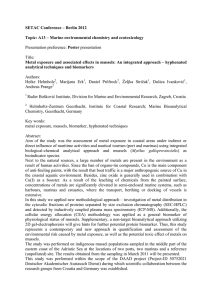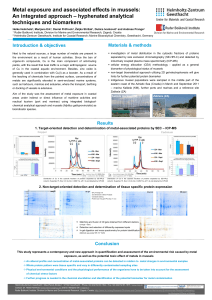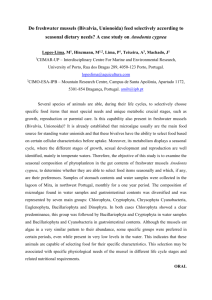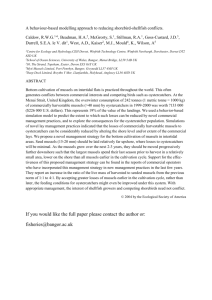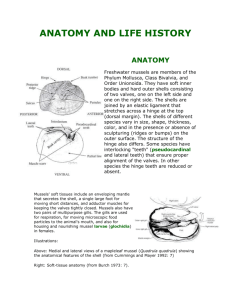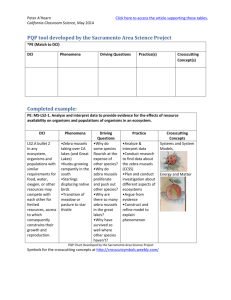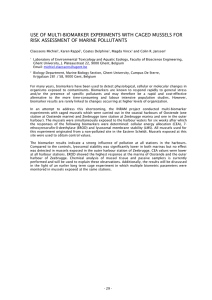Utilization of Proteomic Techni ntial Contamin vironmental Proteo
advertisement
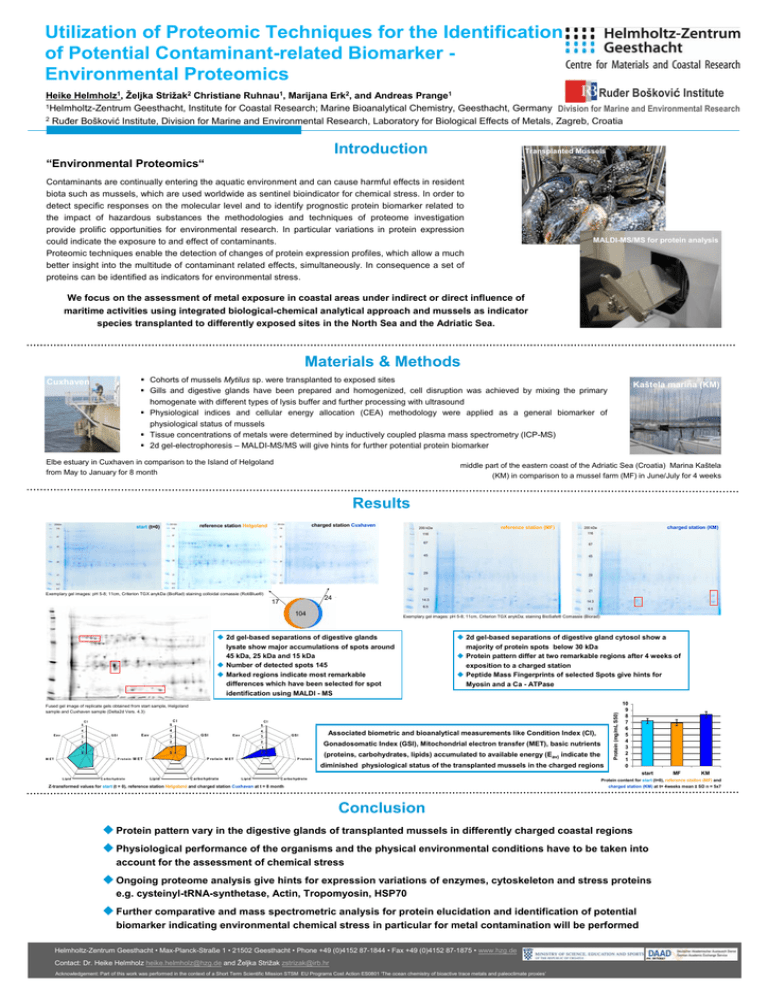
Utilization of Proteomic Techniques for the Identification of Potential Contaminant-related Biomarker Environmental Proteomics Ruđer Bošković Institute Heike Helmholz1, Željka Strižak2 Christiane Ruhnau1, Marijana Erk2, and Andreas Prange1 Geesthacht, Institute for Coastal Research; Marine Bioanalytical Chemistry, Geesthacht, Germany Division for Marine and Environmental Research 2 Ruđer Bošković Institute, Division for Marine and Environmental Research, Laboratory for Biological Effects of Metals, Zagreb, Croatia 1Helmholtz-Zentrum Introduction Transplanted Mussels “Environmental Proteomics“ Contaminants are continually entering the aquatic environment and can cause harmful effects in resident biota such as mussels, which are used worldwide as sentinel bioindicator for chemical stress. In order to detect specific responses on the molecular level and to identify prognostic protein biomarker related to the impact of hazardous substances the methodologies and techniques of proteome investigation provide prolific opportunities for environmental research. In particular variations in protein expression could indicate the exposure to and effect of contaminants. Proteomic techniques enable the detection of changes of protein expression profiles, which allow a much better insight into the multitude of contaminant related effects, simultaneously. In consequence a set of proteins can be identified as indicators for environmental stress. MALDI-MS/MS for protein analysis We focus on the assessment of metal exposure in coastal areas under indirect or direct influence of maritime activities using integrated biological-chemical analytical approach and mussels as indicator species transplanted to differently exposed sites in the North Sea and the Adriatic Sea. Materials & Methods Cohorts of mussels Mytilus sp. were transplanted to exposed sites Gills and digestive glands have been prepared and homogenized, cell disruption was achieved by mixing the primary homogenate with different types of lysis buffer and further processing with ultrasound Physiological indices and cellular energy allocation (CEA) methodology were applied as a general biomarker of physiological status of mussels Tissue concentrations of metals were determined by inductively coupled plasma mass spectrometry (ICP-MS) 2d gel-electrophoresis – MALDI-MS/MS will give hints for further potential protein biomarker Cuxhaven Elbe estuary in Cuxhaven in comparison to the Island of Helgoland from May to January for 8 month Kaštela marina (KM) middle part of the eastern coast of the Adriatic Sea (Croatia) Marina Kaštela (KM) in comparison to a mussel farm (MF) in June/July for 4 weeks Results charged station Cuxhaven reference station Helgoland start (t=0) Exemplary gel images: pH 5-8; 11cm, Criterion TGX anykDa (BioRad) staining colloidal comassie (RotiBlue®) reference station (MF) charged station (KM) 24 17 104 Exemplary gel images: pH 5-8; 11cm, Criterion TGX anykDa; staining BioSafe® Comassie (Biorad) 2d gel-based separations of digestive glands lysate show major accumulations of spots around 45 kDa, 25 kDa and 15 kDa Number of detected spots 145 Marked regions indicate most remarkable differences which have been selected for spot identification using MALDI - MS 2d gel-based separations of digestive gland cytosol show a majority of protein spots below 30 kDa Protein pattern differ at two remarkable regions after 4 weeks of exposition to a charged station Peptide Mass Fingerprints of selected Spots give hints for Myosin and a Ca - ATPase 5 CI 5 3 GS I Eav 3 5 Ea v G SI 3 2 2 1 1 1 0 P ro t e in M E T CI 4 GSI 2 0 M ET CI 4 4 Eav Protein (mg/mL S50) Fused gel image of replicate gels obtained from start sample, Helgoland sample and Cuxhaven sample (Delta2d Vers. 4.3) Associated biometric and bioanalytical measurements like Condition Index (CI), Gonadosomatic Index (GSI), Mitochondrial electron transfer (MET), basic nutrients 0 P ro t e in M E T P ro t e in (proteins, carbohydrates, lipids) accumulated to available energy (Eav) indicate the diminished physiological status of the transplanted mussels in the charged regions 10 9 8 7 6 5 4 3 2 1 0 start Lipid C a rbo hydra t e Lipid C a rbo hydra t e Lipid C a rbo hydra t e MF KM Protein content for start (t=0), reference station (MF) and charged station (KM) at t= 4weeks mean ± SD n = 5x7 Z-transformed values for start (t = 0), reference station Helgoland and charged station Cuxhaven at t = 8 month Conclusion Protein pattern vary in the digestive glands of transplanted mussels in differently charged coastal regions Physiological performance of the organisms and the physical environmental conditions have to be taken into account for the assessment of chemical stress Ongoing proteome analysis give hints for expression variations of enzymes, cytoskeleton and stress proteins e.g. cysteinyl-tRNA-synthetase, Actin, Tropomyosin, HSP70 Further comparative and mass spectrometric analysis for protein elucidation and identification of potential biomarker indicating environmental chemical stress in particular for metal contamination will be performed Helmholtz-Zentrum Geesthacht • Max-Planck-Straße 1 • 21502 Geesthacht • Phone +49 (0)4152 87-1844 • Fax +49 (0)4152 87-1875 • www.hzg.de Contact: Dr. Heike Helmholz heike.helmholz@hzg.de and Željka Strižak zstrizak@irb.hr Acknowledgement: Part of this work was performed in the context of a Short Term Scientific Mission STSM EU Programs Cost Action ES0801 ‘The ocean chemistry of bioactive trace metals and paleoclimate proxies’ PK: 50752021
